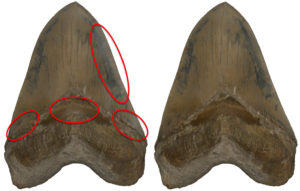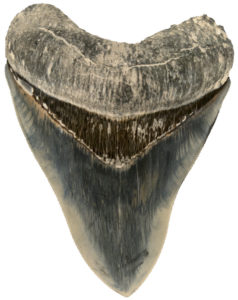Introduction
 Few sights elicit a terror quite as dreadful as the toothy grin of a massive shark. While the movie Jaws may have taken some creative liberties with the size of the great white shark, the visual of an apex-predator with rows of razor-sharp teeth captured the imagination of millions and helped popularize the aesthetic of shark teeth in fashion and culture. While great white shark teeth may appear quite scary at first, they are baby-teeth in size compared to those belonging to the mighty Megalodon. The first evidence of Otodus megalodon, or “big tooth”, suggests they appeared around 20 million years ago and went extinct around 3 million years ago. As one of the largest predators to ever have lived, growing up to 60 ft long, we may never have known of their existence were it not for the fossilized teeth they left behind. Sharks are able to continuously produce new teeth during their lifespan, replacing old and damaged teeth which then rain down on the sea floor to be preserved via fossilization. In addition, a shark’s skeletal structure is primarily made of cartilage, meaning their hardened teeth are some of the only fossilized evidence we have of their existence. Prized for their beauty, rarity, and size, and serving as a tangible reminder of who owns the deep waters on planet Earth, Megalodon teeth are a prime target for preservation via high accuracy color 3D scanning.
Few sights elicit a terror quite as dreadful as the toothy grin of a massive shark. While the movie Jaws may have taken some creative liberties with the size of the great white shark, the visual of an apex-predator with rows of razor-sharp teeth captured the imagination of millions and helped popularize the aesthetic of shark teeth in fashion and culture. While great white shark teeth may appear quite scary at first, they are baby-teeth in size compared to those belonging to the mighty Megalodon. The first evidence of Otodus megalodon, or “big tooth”, suggests they appeared around 20 million years ago and went extinct around 3 million years ago. As one of the largest predators to ever have lived, growing up to 60 ft long, we may never have known of their existence were it not for the fossilized teeth they left behind. Sharks are able to continuously produce new teeth during their lifespan, replacing old and damaged teeth which then rain down on the sea floor to be preserved via fossilization. In addition, a shark’s skeletal structure is primarily made of cartilage, meaning their hardened teeth are some of the only fossilized evidence we have of their existence. Prized for their beauty, rarity, and size, and serving as a tangible reminder of who owns the deep waters on planet Earth, Megalodon teeth are a prime target for preservation via high accuracy color 3D scanning.
History of Portable 3D Scanning
Twenty years ago, the idea of color 3D scanning small intricate objects such as serrated shark teeth seemed more science fiction than fact. Portable 3D scanning in the early years (1980s-1990s) focused on digitizing large objects such as trains, ships, and buildings. Although the steady march of progress ensured high resolution color 3D scanning would eventually be introduced, for decades, rare fossils and antiquities existed in a limbo where modern preservation and photographic techniques could be utilized, but portable 3D scanning was not yet advanced enough to provide research-quality results. The growth of modern portable 3D scanners starting in the 2000s and culminating with the advent of low cost, handheld, LED-light-based 3D scanners in the early 2010s (Such as the Artec Spider/Space Spider) has opened massive new frontiers in the world of portable 3D scanning, particularly small items with intricate details.

About the Teeth
 Like all fossils, megalodon teeth come in many different quality levels and are very fragile – dropping one will almost surely break or chip it! Megalodon teeth only remain in pristine condition when they have been fossilized and encased in rock for millions of years, providing the “armor” they need to remain intact. Over time, organic material within the tooth is replaced by inorganic material, resulting in a fossil that feels like fine porcelain and will not rot. When they are found, the teeth are delicately removed from their rocky matrix and evaluated for completeness in several key areas: the quality of the enamel and the blade, whether any serrations are missing, the completeness of the root, the color of all features, and the overall quality of the bourlette (the triangular shaped off-color area at the base of the enamel). Unique tooth pathology is also highly desired for its rarity, such as teeth that are bent, warped, or otherwise misshapen. Color is critical for a tooths value in research: the colors can inform what kind of material preserved the tooth, the integrity of the matrix and whether it allowed water, plants, or animals to permeate during fossilization, and even the nutritional quality of the shark as it was growing. Color can also hint at the location where the shark existed. Although found all over the world, some of the most richly colorful teeth have been found off the coast of the island Java in Indonesia.
Like all fossils, megalodon teeth come in many different quality levels and are very fragile – dropping one will almost surely break or chip it! Megalodon teeth only remain in pristine condition when they have been fossilized and encased in rock for millions of years, providing the “armor” they need to remain intact. Over time, organic material within the tooth is replaced by inorganic material, resulting in a fossil that feels like fine porcelain and will not rot. When they are found, the teeth are delicately removed from their rocky matrix and evaluated for completeness in several key areas: the quality of the enamel and the blade, whether any serrations are missing, the completeness of the root, the color of all features, and the overall quality of the bourlette (the triangular shaped off-color area at the base of the enamel). Unique tooth pathology is also highly desired for its rarity, such as teeth that are bent, warped, or otherwise misshapen. Color is critical for a tooths value in research: the colors can inform what kind of material preserved the tooth, the integrity of the matrix and whether it allowed water, plants, or animals to permeate during fossilization, and even the nutritional quality of the shark as it was growing. Color can also hint at the location where the shark existed. Although found all over the world, some of the most richly colorful teeth have been found off the coast of the island Java in Indonesia.
3D Scanning
In 2021, Laser Design was contracted to digitize a collection of some of the finest Megalodon teeth in the world. Immortal Artifacts, owners of the one of the largest collections of high quality megalodon teeth, contacted Laser Design to learn more about whether 3D scanning could be a possible solution to their preservation challenges. Laser Design’s 30+ year experience using high resolution 3D scanning technologies was a perfect fit for these fossils. Working in tandem with the Science Museum of Minnesota®, Laser Design provided high accuracy 3D scanning services in full color to produce exact digital copies. After scanning, physical molds were taken of the teeth by museum specialists for use in creating extremely fine replicas. Working with a museum like this helps maximize the long term-preservation without having to lock them in an air-tight vault for the rest of time. Laser Design’s high resolution 3D scanning services provided the perfect scanning solution at a low cost due to the special talents and equipment of the scanning team, all while safely measuring them in a non-contact way.

Choosing the Right Technology
Laser Design would need to choose the best scanning technology in order to produce the highest quality and most compelling data. The fine serrations of the teeth require both a high resolution (level of detail) as well as accuracy (how close the scan data’s dimensions are to reality) to resolve the tiny, critical features. In addition, the serrations in some parts of the tooth would occlude others, so a complex scanning path would be needed to capture the top, bottom, and sides of every single serration. Furthermore, color would need to be captured and incorporated directly into the scanning process such that every pixel of color is matched perfectly to the location on the teeth without room for artistic interpretation.
Laser Design used the Artec Space Spider handheld 3D scanner along with a special custom-made tooth-scanning fixture and turntable that allowed each tooth to be delicately repositioned to allow easy scanning from all angles without risking damage to the tooth. To use a rigid fixture such as a vise would possibly damage the prehistoric fossils, so a soft-contact scanning stage using moldable putty-like sand was used to allow the tooth to be repositioned safely. The handheld nature of the Artec Space Spider scanner allowed the scanning technician to easily capture all sides using a simple turntable, and data was then loaded into Artec Studio software to align the scans together, fuse into a single model, and then wrap with the captured color data. This process resulted in data with an average accuracy of +/- 0.05 mm and an average resolution of 0.1 mm point spacing, all in full, photorealistic color!
Wrapping it up
The spirit of preservation is about protecting objects and features of historical importance, conserving them for future generations and our collective cultural growth. 3D scanning fits neatly into this philosophy, by allowing schools, museums, and other organizations to share important fossils and artifacts without compromising the integrity of the originals. The portability of digital files means that 3D scanned objects can be viewed by researchers and casual viewers around the world, only expanding our collective understanding of natural history. Contact us today to learn more about 3D scanning solutions. Our experienced team of 3D scanning experts is available to answer any questions you may have about choosing the right 3D scanning service or system solution to fit your specific needs. We look forward to working together!
About Immortal Artifacts
Immortal Artifacts is a cross-functional group of scientists, engineers, collectors, and enthusiasts with the shared mission to ‘use cutting edge technology to protect and spread the history of life’. With preservation and education as its core tenets – Immortal believes there is an opportunity to combine 3D scanning, blockchain, and other technology to reinvent and improve the experience of collecting and owning fossils and artifacts.
Want to get involved? Join the conversation and engage with the passionate community on the Immortal Discord Channel, or learn more at https://immortal.art.






